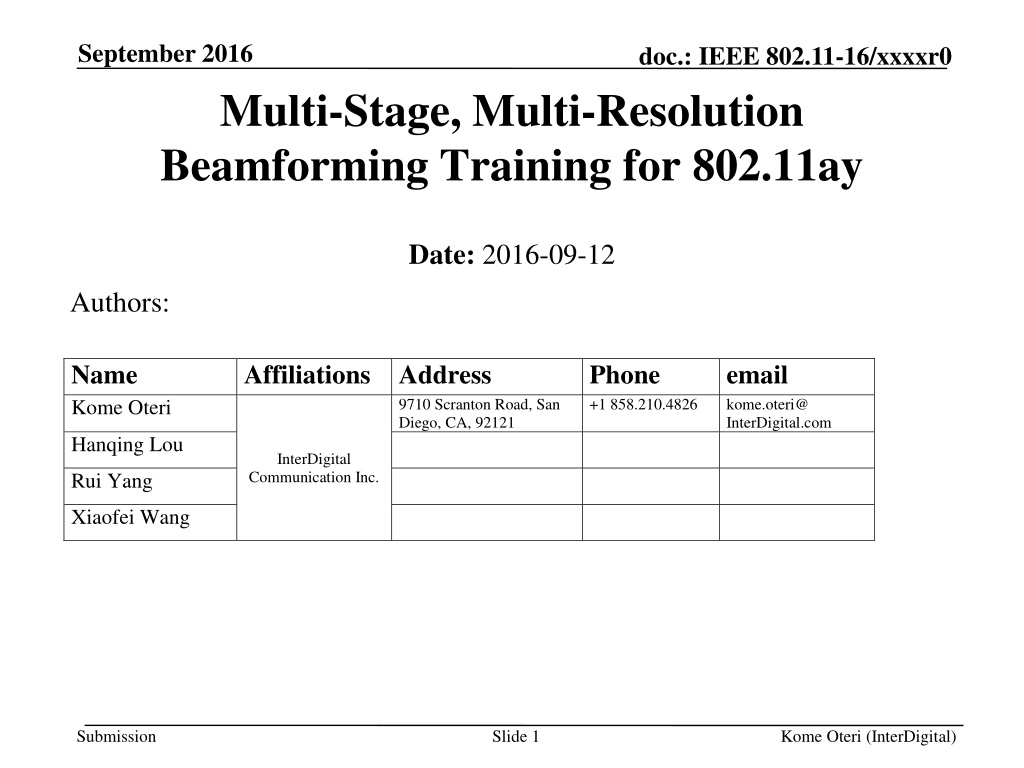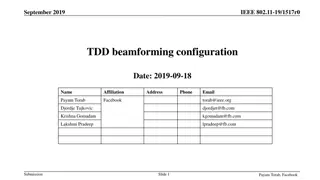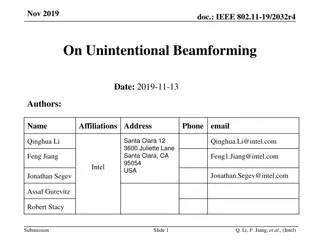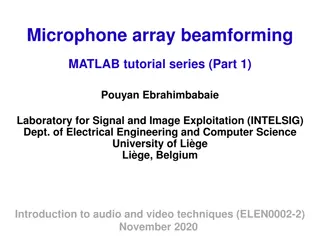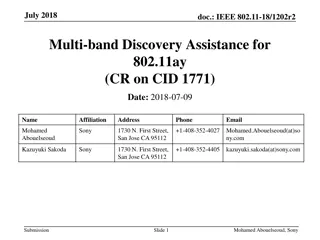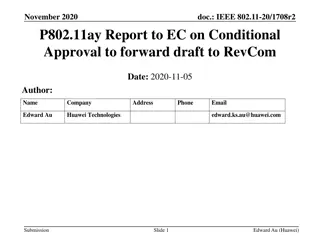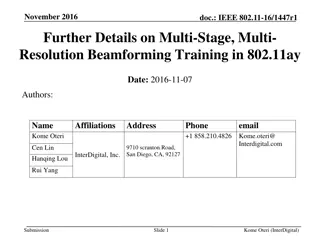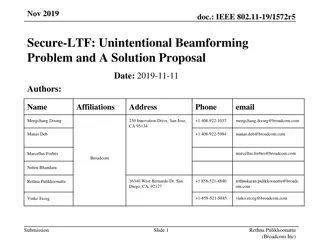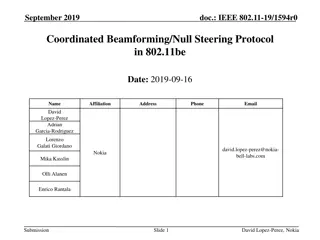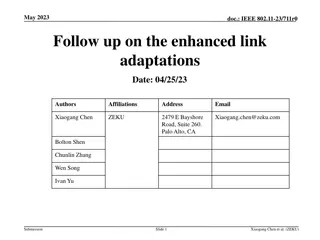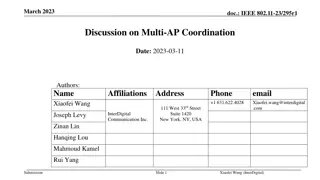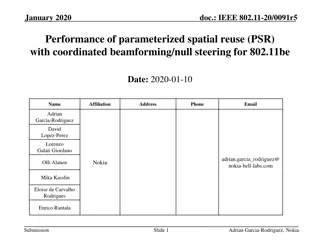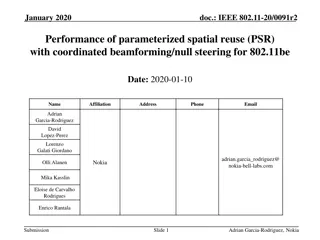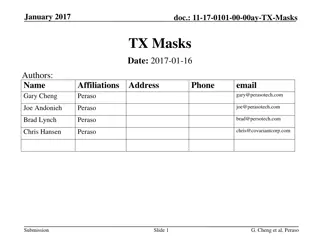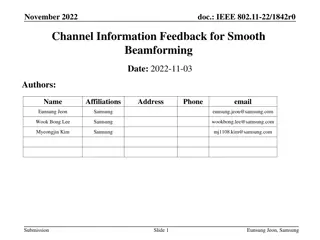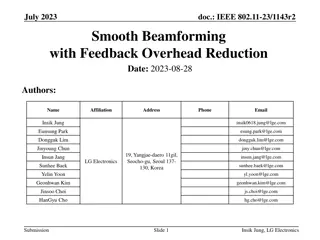Multi-Stage, Multi-Resolution Beamforming Training for IEEE 802.11ay
In September 2016, a proposal was introduced to enhance the beamforming training procedures in IEEE 802.11ay for increased efficiency and MIMO support. The proposal suggests a multi-stage, multi-resolution beamforming training framework to improve efficiency in scenarios with high-resolution beams and enable more effective beam tracking. The framework includes agreements to support simultaneous training of transmit and receive antennas, sector down-selection, and multi-beamforming for multiple array antennas. Additionally, a detailed breakdown of the proposed multi-stage, multi-resolution beamforming training process is outlined to show the different levels and angular resolutions involved.
Download Presentation

Please find below an Image/Link to download the presentation.
The content on the website is provided AS IS for your information and personal use only. It may not be sold, licensed, or shared on other websites without obtaining consent from the author. Download presentation by click this link. If you encounter any issues during the download, it is possible that the publisher has removed the file from their server.
E N D
Presentation Transcript
September 2016 doc.: IEEE 802.11-16/xxxxr0 Multi-Stage, Multi-Resolution Beamforming Training for 802.11ay Date: 2016-09-12 Authors: Name Kome Oteri Affiliations Address InterDigital Communication Inc. Phone +1 858.210.4826 email kome.oteri@ InterDigital.com 9710 Scranton Road, San Diego, CA, 92121 Hanqing Lou Rui Yang Xiaofei Wang Submission Slide 1 Kome Oteri (InterDigital)
September 2016 doc.: IEEE 802.11-16/xxxxr0 Introduction In 802.11ay, enhancements to the 802.11ad beamforming training procedures have been agreed on for complexity reduction, efficiency and to enable MIMO BF training [1][2][3][4]. In this contribution, we propose a multi-stage, multi- resolution beamforming training (BFT) framework to further increase the BF training efficiency in scenarios with high resolution beams. The scheme also has advantages that enable more efficient beam tracking. Submission Slide 2 Kome Oteri (InterDigital)
September 2016 doc.: IEEE 802.11-16/xxxxr0 Current BF Agreements The following agreements have been made to improve BF training in 802.11ay [4]: The 11ay beamforming protocol shall enable TX and RX training using the same BRP frame. enable simultaneous BF training of transmit DMG antennas. support simultaneous RX antenna training. provide the means to enable TX sector down selection as part of beamforming training. support, for STAs with antenna pattern reciprocity, RX sector down selection as part of beamforming training. support a mode of operation in which, in a single phase, the initiator trains its transmit antennas/sectors and multiple responders train their receive antennas/sectors. The 11ay beamforming protocol supports multi-beamforming for multiple array antennas. Multi-beamforming means that a transmitter simultaneously sends SSW frames in multiple polarized directions. Submission Slide 3 Kome Oteri (InterDigital)
September 2016 doc.: IEEE 802.11-16/xxxxr0 Multi-Stage, Multi-Resolution BFT To further increase the efficiency of the beamforming training procedure with high resolution beamforming, we propose that 802.11ay support the use of a multi-stage, multi-resolution beamforming framework [5]. In this framework, beams of increasing angular resolution can be used at different stages of the sector sweep, beam refinement or tracking procedure. To support this scheme in 802.11ay, signaling should be added to indicate the capability to perform multi-stage, multi-resolution BFT and to signal resolution information such as the maximum and current beam resolutions. Submission Slide 4 Kome Oteri (InterDigital)
September 2016 doc.: IEEE 802.11-16/xxxxr0 Multi-Stage, Multi-Resolution BFT L0: Sector Level Sweep: Identify Sector of angular spread 90 degrees L1: BFT Level 1: 4 beams per sector with angular spread 22.5 degrees L2: BFT Level 2: 4 beams per beam Level 1 or 16 beams per sector with angular spread 5.625 degrees L3: BFT Level 3/ Non-hierarchical BRP: 4 beams per beam Level 2 or 64 beams per sector with angular spread 1.046 degrees. Submission Slide 5 Kome Oteri (InterDigital)
September 2016 doc.: IEEE 802.11-16/xxxxr0 Example Sector Index beam Index 1 2 3 4 5 6 7 8 9 10 11 12 13 14 15 16 17 18 19 20 21 22 23 24 25 26 27 28 29 30 31 32 33 34 35 36 37 38 39 40 41 42 43 44 45 46 47 48 49 50 51 52 53 54 55 56 57 58 59 60 61 62 63 64 Feedback beam Index 19 Beam = Sector 1, beam 19 Single Resolution beam sweep : 64 beam sweeps and 1 feedback frame Resolution Index 1 Resolution Index 2 Resolution Index 3 Resolution Index 4 Sector Index L1 Index beam Index 1 2 3 4 5 6 7 8 9 10 11 12 13 14 15 16 17 18 19 20 21 22 23 24 25 26 27 28 29 30 31 32 33 34 35 36 37 38 39 40 41 42 43 44 45 46 47 48 49 50 51 52 53 54 55 56 57 58 59 60 61 62 63 64 1 1 1 1 1 1 1 1 1 1 1 1 1 1 1 1 2 2 2 2 2 2 2 2 2 2 2 2 2 2 2 2 3 3 3 3 3 3 3 3 3 3 3 3 3 3 3 3 4 4 4 4 4 4 4 4 4 4 4 4 4 4 4 4 Feedback L1 index = 2 L2 Index beam Index 1 1 1 1 2 2 2 2 3 3 3 3 4 4 4 4 17 18 19 20 21 22 23 24 25 26 27 28 29 30 31 32 Feedack L2 Index = 1 L3 Index beam Index 1 2 3 4 17 18 19 20 Feedback L3 Index = 3 Beam = Sector 1, L1:beam 2, L2:beam 1, L3:beam 3 Multi-stage, Multi-resolution beam sweep: 12 beam sweeps and 3 feedback frames Submission Slide 6 Kome Oteri (InterDigital)
September 2016 doc.: IEEE 802.11-16/xxxxr0 BFT Protocol AP BFT 1 2 3 64 Feedback Tx Sector 19 STA1 Rx Sector 3 from AP Single Resolution BF Training AP BFT 1,1 1,2 1, 3 1, 4 Stage 1 Feedback Tx Sector 1,2 STA1 Rx Sector 3 AP BFT 1,2,1 1,2,2 1,2,3 1,2,4 Stage 2 Feedback Tx Sector 1,2,1 STA1 Rx Sector 3 AP BFT 1,2,1,1 1,2,1,2 1,2,1,3 1,2,1,4 Stage 3 Feedback Tx Sector 1,2,1,3 = 19 STA1 Rx Sector 3 Multi-stage, Multi-Resolution BF Training Submission Slide 7 Kome Oteri (InterDigital)
September 2016 doc.: IEEE 802.11-16/xxxxr0 Advantages of Multi-Stage, Multi- Resolution BFT The overall number of training beams transmitted for a narrow beam system can be reduced. This is important especially in MIMO scenarios where multiple transmit-receive pairs are needed. Connection between the transmitter-receiver pair can be made at any stage without the need for a long wait. The procedure can also be combined with beam down-selection. The initiator or responder can request training at a particular resolution level and dynamically trade-off BFT efficiency and beam accuracy. A node can request for BFT with a resolution fallback in case of a change in the channel which is advantageous for beam tracking Submission Slide 8 Kome Oteri (InterDigital)
September 2016 doc.: IEEE 802.11-16/xxxxr0 Conclusion Multi-stage Multi-resolution BFT offers improvements in BF training efficiency and beam tracking for high resolution beams. Signaling should be added to 802.11ay to indicate the capability to perform multi-stage, multi-resolution beam tracking and to signal information such as the maximum and current beam resolutions Submission Slide 9 Kome Oteri (InterDigital)
September 2016 doc.: IEEE 802.11-16/xxxxr0 Straw Polls Do you agree to add the following text into the 802.11ay SFD? 11ay shall support multi-stage, multi-resolution beamforming training as part of the beamforming training procedure Submission Slide 10 Kome Oteri (InterDigital)
September 2016 doc.: IEEE 802.11-16/xxxxr0 References 1. IEEE 802.11-16/0100r3, MIMO BF Training Enhancements, Wang et. al., Jan 2016 IEEE 802.11-16/0316r0, Low Complexity Beamtraining for Hybrid MIMO, Fellhauer et. al., March 2016 IEEE 802.11-16/0420r1, BF Training for SU MIMO, Huang et. al., March 2016 IEEE 802.11-15/1358r5, Specification Framework for TGay, Cordeiro, August 2016 Noh, Song, Michael D. Zoltowski, and David J. Love. "Multi- Resolution Codebook Based Beamforming Sequence Design in Millimeter-Wave Systems." 2015 IEEE Global Communications Conference (GLOBECOM). IEEE, 2015. 2. 3. 4. 5. Submission Slide 11 Kome Oteri (InterDigital)
